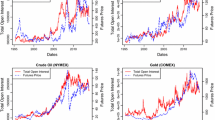Abstract
This paper examines the behavior of a competitive firm that faces joint price and inflation risk. Given that the price risk is negatively correlated with the inflation risk in the sense of expectation dependence, we show that the firm optimally opts for an over-hedge (under-hedge) if the firm’s coefficient of relative risk aversion is everywhere no greater (no smaller) than unity. We show further that banning the firm from forward trading may induce the firm to produce more or less, depending on whether the price risk premium is positive or negative, respectively. While the price risk premium is unambiguously negative in the absence of the inflation risk, it is not the case when the inflation risk prevails. In contrast to the conventional wisdom, forward hedging needs not always promote production should firms take inflation seriously.
Similar content being viewed by others
Notes
The strict convexity of C(Q) is driven by the firm’s production technology that exhibits decreasing returns to scale.
Throughout the paper, random variables have a tilde (∼) while their realizations do not.
The less likely case wherein \(\tilde {P}\) and \(\tilde {Z}\) are positively expectation dependent can be analogously analyzed.
For any two random variables, \(\tilde {X}\) and \(\tilde {Y}\), it is true that \(\text {Cov}(\tilde {X},\tilde {Y})=\mathrm {E}(\tilde {X}\tilde {Y}) -\mathrm {E}(\tilde {X})\mathrm {E}(\tilde {Y})\).
If R(Π) = 1 for all Π > 0, i.e, the firm has a logarithmic utility function, the firm’s optimal forward position is a full-hedge, i.e., X ∗ = Q ∗.
References
Adam-Müller AFA (2002a) What to do if a dollar is not a dollar? The impact of inflation risk on production and risk management. J Futur Mark 22:371–386
Adam-Müller AFA (2002b) Hedging price risk when real wealth matters. J Int Money Financ 19:549–560
Battermann HL, Broll U (2001) Inflation risk, hedging, and exports. Rev Dev Econ 5:355–362
Broll U, Welzel P, Wong KP (2015) Futures hedging with basis risk and expectation dependence. Int Rev Econ 62:213–221
Cuadras CM (2002) On the covariance between functions. J Multivar Anal 81:19–27
Holthausen DM (1979) Hedging and the competitive firm under price uncertainty. Am Econ Rev 69:989–995
Li J (2011) The demand for a risky asset in the presence of a background risk. J Econ Theory 146:372–391
Sandmo A (1971) On the theory of the competitive firm under price uncertainty. Am Econ Rev 61:65–73
Wong KP (2012) Production and hedging under state-dependent preferences. J Futur Mark 32:945–963
Wong KP (2013) A note on exports and hedging exchange rate risks: the multi-country case. J Futur Mark 33:1191–1196
Wright R (1987) Expectation dependence of random variables, with an application in portfolio theory. Theor Decis 22:111–124
Acknowledgments
The authors thank an anonymous referee and Odd Rune Straume (co-editor) for their very helpful comments and suggestion.
Author information
Authors and Affiliations
Corresponding author
About this article
Cite this article
Broll, U., Wong, K.P. The impact of inflation risk on forward trading and production. Port Econ J 14, 65–73 (2015). https://doi.org/10.1007/s10258-015-0109-y
Received:
Accepted:
Published:
Issue Date:
DOI: https://doi.org/10.1007/s10258-015-0109-y




